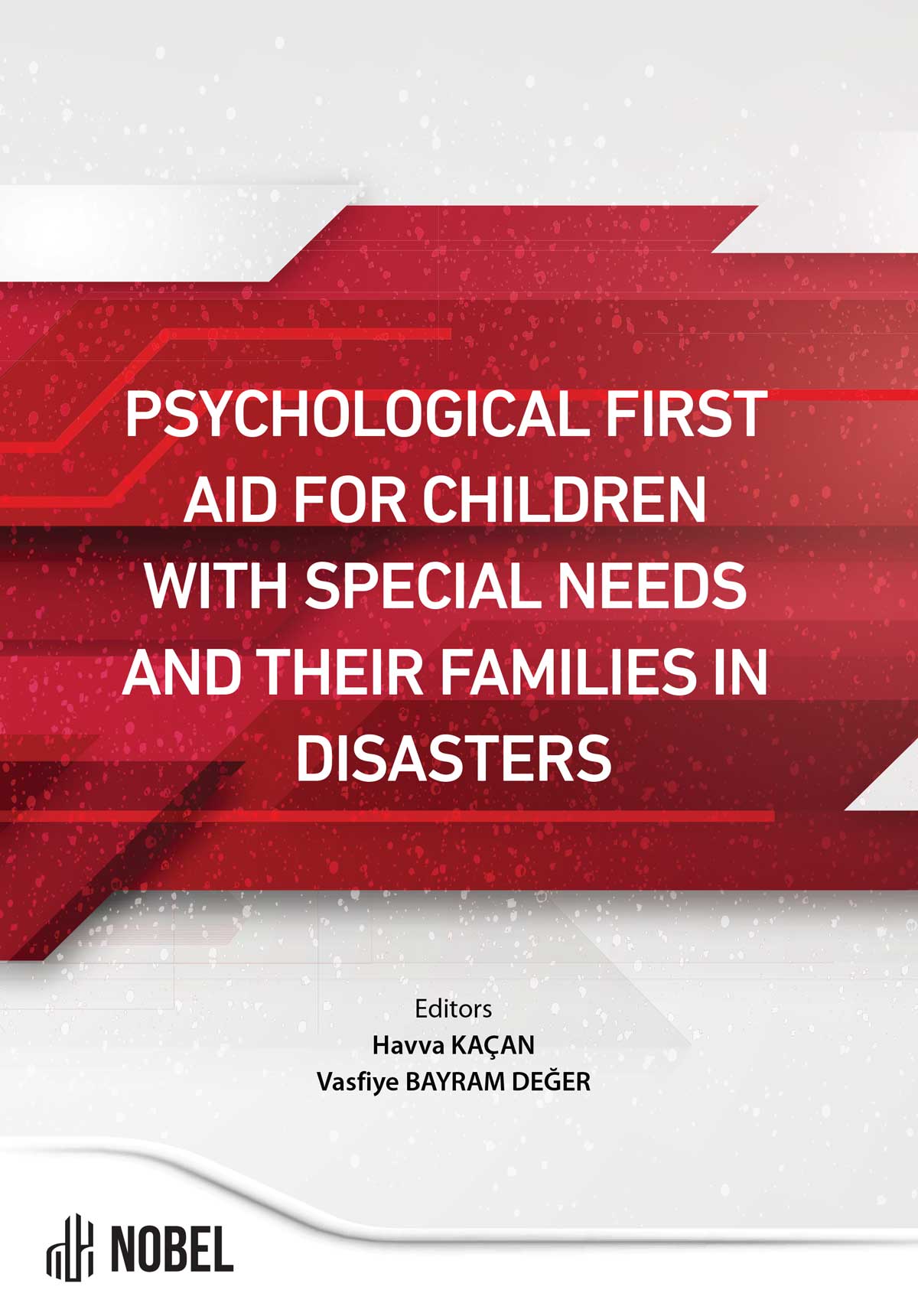Supporting to Meet the Psychosocial Basic Needs of Children with Special Needs After Disaster
Kubra Tan (Author), Funda Gumus (Author)
Release Date:
Th is chapter delves into the children with special needs, ımpact of disasters on children with special needs, determining the psychosocial basic needs of children with special needs aft er the disaster, ınterventions that can be applied to children with special needs aft er disaster, post-disaster support for parents of children with special needs children [...]
Media Type
Buy from
Price may vary by retailers
| Work Type | Book Chapter |
|---|---|
| Published in | Psychological First Aid for Children with Special Needs and Their Families in Disasters |
| First Page | 103 |
| Last Page | 111 |
| DOI | https://doi.org/10.69860/nobel.9786053358800.9 |
| Page Count | 9 |
| Copyright Holder | Nobel Tıp Kitabevleri |
| License | https://nobelpub.com/publish-with-us/copyright-and-licensing |
Kubra Tan (Author)
Asst. Prof. Dr., Artvin Coruh University
https://orcid.org/0000-0002-7591-8436
Funda Gumus (Author)
Assistant Professor, Artvin Coruh University
https://orcid.org/0000-0002-3827-0909
World Health Organization (2016). International classification of diseases (ICD-10). Retrieved from: http:// apps.who.int/classifications/icd10/browse/2016/en#/F70-F79 Accessed April 11, 2024.
Chin, K., Simmons, T., & Burke, R. V. A mixed-method analysis: Disaster preparedness of families with children with access and functional needs. American journal of disaster medicine, 2020; 15(3): 187-197.
Türkiye İstatistik Kurumu (TÜİK). (2022). https://data.tuik.gov.tr/Bulten/Index?p=Istatistiklerle- Cocuk-2022-49674 Erişim Tarihi: Nisan 2024
Bethell, C. D., Read, D., Blumberg, S. J., & Newacheck, P. W. What is the prevalence of children with special health care needs? Toward an understanding of variations in findings and methods across three national surveys. Maternal and child health journal, 2008;12:1-14.
Flasch, E. A. Health Equity and Children With Medical Complexity/Children and Youth With Special Health Care Needs: A Scoping Review. Journal of Pediatric Health Care, 2024:38(2), 210-218.
Tatsukı, S. Challenges in counter‐disaster measures for people with functional needs in times of disaster following the Great East Japan earthquake. International Journal of Japanese Sociology, 2012; 21(1):12-20.
Reinhardt J.D, Li J., Gosney J., et al. Disability and health-related rehabilitation in international disaster relief. Global Health Action. 2011;4:7191.
Turgut A., Cansabuncu G. Deprem sonrası ortopedik yaralanmalı çocuk hasta, kompartman sendromu. TOTBİD Dergisi. 2022;21:289-293.
. Saeed, S. A., & Gargano, S. P. Natural disasters and mental health. International review of psychiatry, 2002; 34(1), 16-25.
Murray, J. S. Disaster preparedness for children with special healthcare needs and disabilities. Journal for Specialists in Pediatric Nursing, 2011;16(3).
Yamamoto, M., Nakagawa, K., Ishigami, Y. et al. Difficulties living in a disaster and anxiety in life: Characteristicsof the experiences of severely disabled children living in the Tokyo metropolitan area during the GreatEast Japan Earthquake. The journal of child health, 2013; 72(2): 298-304.
Smith, N., Donaldson, M., Mitton, C., & Lee, E. Communication in disasters to support families with children with medical complexity and special healthcare needs: a rapid scoping review. Frontiers in public health, 2024; 12: 1229738.
Turchi, R. M., Antonelli, R., & Norwood, K. W. Council on Children with Disabilities and Medical Home Implementation Project Advisory Committee.“Patient-and Family-Centered Care Coordination: A Framework for Integrating Care for Children and Youth across Multiple Systems.”. Pediatrics, 2014; 133(5):e1451-e1460.
Pankewicz, A., Davis, R. K., Kim, J., Antonelli, R., Rosenberg, H., Berhane, Z., & Turchi, R. M. Children with special needs: social determinants of health and care coordination. Clinical pediatrics, 2020; 59(13):1161- 1168.
Kimura, M. Negative social interactions and coping behaviors: experiences of Japanese mothers caring for children with special needs in disaster areas. BMC Research Notes, 2020;13: 1-6
| onix_3.0::thoth | Thoth ONIX 3.0 |
|---|---|
| onix_3.0::project_muse | Project MUSE ONIX 3.0 |
| onix_3.0::oapen | OAPEN ONIX 3.0 |
| onix_3.0::jstor | JSTOR ONIX 3.0 |
| onix_3.0::google_books | Google Books ONIX 3.0 |
| onix_3.0::overdrive | OverDrive ONIX 3.0 |
| onix_2.1::ebsco_host | EBSCO Host ONIX 2.1 |
| csv::thoth | Thoth CSV |
| json::thoth | Thoth JSON |
| kbart::oclc | OCLC KBART |
| bibtex::thoth | Thoth BibTeX |
| doideposit::crossref | CrossRef DOI deposit |
| onix_2.1::proquest_ebrary | ProQuest Ebrary ONIX 2.1 |
| marc21record::thoth | Thoth MARC 21 Record |
| marc21markup::thoth | Thoth MARC 21 Markup |
| marc21xml::thoth | Thoth MARC 21 XML |

